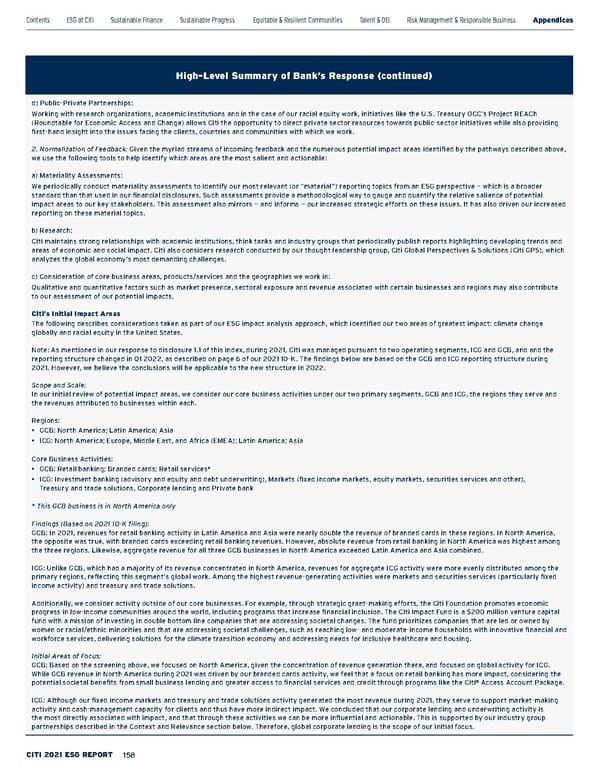High-Level Summary of Bank’s Response (continued) d) Public-Private Partnerships: Working with research organizations, academic institutions and in the case of our racial equity work, initiatives like the U.S. Treasury OCC’s Project REACh (Roundtable for Economic Access and Change) allows Citi the opportunity to direct private sector resources towards public-sector initiatives while also providing first-hand insight into the issues facing the clients, countries and communities with which we work. 2. Normalization of Feedback: Given the myriad streams of incoming feedback and the numerous potential impact areas identified by the pathways described above, we use the following tools to help identify which areas are the most salient and actionable: a) Materiality Assessments: We periodically conduct materiality assessments to identify our most relevant (or “material”) reporting topics from an ESG perspective — which is a broader standard than that used in our financial disclosures. Such assessments provide a methodological way to gauge and quantify the relative salience of potential impact areas to our key stakeholders. This assessment also mirrors — and informs — our increased strategic efforts on these issues. It has also driven our increased reporting on these material topics. b) Research: Citi maintains strong relationships with academic institutions, think tanks and industry groups that periodically publish reports highlighting developing trends and areas of economic and social impact. Citi also considers research conducted by our thought leadership group, Citi Global Perspectives & Solutions (Citi GPS), which analyzes the global economy’s most demanding challenges. c) Consideration of core business areas, products/services and the geographies we work in: Qualitative and quantitative factors such as market presence, sectoral exposure and revenue associated with certain businesses and regions may also contribute to our assessment of our potential impacts. Citi’s Initial Impact Areas The following describes considerations taken as part of our ESG impact analysis approach, which identified our two areas of greatest impact: climate change globally and racial equity in the United States. Note: As mentioned in our response to disclosure 1.1 of this index, during 2021, Citi was managed pursuant to two operating segments, ICG and GCB, and and the reporting structure changed in Q1 2022, as described on page 6 of our 2021 10-K. The findings below are based on the GCB and ICG reporting structure during 2021. However, we believe the conclusions will be applicable to the new structure in 2022. Scope and Scale: In our initial review of potential impact areas, we consider our core business activities under our two primary segments, GCB and ICG, the regions they serve and the revenues attributed to businesses within each. Regions: • GCB: North America; Latin America; Asia • ICG: North America; Europe, Middle East, and Africa (EMEA); Latin America; Asia Core Business Activities: • GCB: Retail banking; Branded cards; Retail services* • ICG: Investment banking (advisory and equity and debt underwriting), Markets (fixed income markets, equity markets, securities services and other), Treasury and trade solutions, Corporate lending and Private bank * This GCB business is in North America only Findings (Based on 2021 10-K filing): GCB: In 2021, revenues for retail banking activity in Latin America and Asia were nearly double the revenue of branded cards in these regions. In North America, the opposite was true, with branded cards exceeding retail banking revenues. However, absolute revenue from retail banking in North America was highest among the three regions. Likewise, aggregate revenue for all three GCB businesses in North America exceeded Latin America and Asia combined. ICG: Unlike GCB, which had a majority of its revenue concentrated in North America, revenues for aggregate ICG activity were more evenly distributed among the primary regions, reflecting this segment’s global work. Among the highest revenue-generating activities were markets and securities services (particularly fixed income activity) and treasury and trade solutions. Additionally, we consider activity outside of our core businesses. For example, through strategic grant-making efforts, the Citi Foundation promotes economic progress in low-income communities around the world, including programs that increase financial inclusion. The Citi Impact Fund is a $200 million venture capital fund with a mission of investing in double bottom line companies that are addressing societal changes. The fund prioritizes companies that are led or owned by women or racial/ethnic minorities and that are addressing societal challenges, such as reaching low- and moderate-income households with innovative financial and workforce services, delivering solutions for the climate transition economy and addressing needs for inclusive healthcare and housing. Initial Areas of Focus: GCB: Based on the screening above, we focused on North America, given the concentration of revenue generation there, and focused on global activity for ICG. While GCB revenue in North America during 2021 was driven by our branded cards activity, we feel that a focus on retail banking has more impact, considering the potential societal benefits from small business lending and greater access to financial services and credit through programs like the Citi ® Access Account Package. ICG: Although our fixed income markets and treasury and trade solutions activity generated the most revenue during 2021, they serve to support market-making activity and cash-management capacity for clients and thus have more indirect impact. We concluded that our corporate lending and underwriting activity is the most directly associated with impact, and that through these activities we can be more influential and actionable. This is supported by our industry group partnerships described in the Context and Relevance section below. Therefore, global corporate lending is the scope of our initial focus. Contents ESGatCiti SustainableFinance SustainableProgress Equitable&ResilientCommunities Talent&DEI RiskManagement&ResponsibleBusiness Appendices ESGS ataC ius niblnG 158
 Citi ESG Report Page 157 Page 159
Citi ESG Report Page 157 Page 159